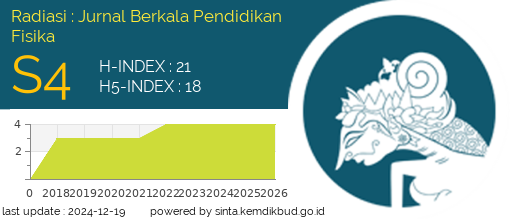The Trend of Research Critical Thinking Skills in Physics Education Journal Evolution in Physics Education Journals across Indonesia: From Research Design to Data Analysis
Abstract
Critical thinking skill is important that needs to be developed in 21st-century education. This research aims to conduct a content analysis of articles published in physics education journals throughout Indonesia from 2017 to 2022, with a focus on critical thinking skills. The findings of this study show an increase in the number of publications related to critical thinking skills each year. The most used research design is quantitative research, with the main research subjects being high school students in grades X dan XI. The most frequently used physics material topic is fluid and mechanics. The analysis method most used by researchers is N-gain and t-test. Therefore, the findings of this research recommend that future critical thinking skills research consider variations in research design, research subject, data analysis method, and physics material topic.
Downloads
References
A. S. Puspita and S. Aloysius, “Developing student’s critical thinking skills through implementation of problem based learning approach,” J. Phys. Conf. Ser., vol. 1241, no. 1, 2019, doi: 10.1088/1742-6596/1241/1/012020.
B. Mitrevski, “Teaching critical thinking and problem solving in physics,” AIP Conf. Proc., vol. 2075, no. February 2017, 2019, doi: 10.1063/1.5091398.
Y. A. Pratama, W. Sopandi, and Y. Hidayah, “RADEC Learning Model (Read-Answer-Discuss-Explain And Create): The Importance of Building Critical Thinking Skills In Indonesian Context,” Int. J. Educ. Vocat. Stud., vol. 1, no. 2, pp. 109–115, 2019, doi: 10.29103/ijevs.v1i2.1379.
D. T. Tiruneh, M. De Cock, A. G. Weldeslassie, J. Elen, and R. Janssen, “Measuring Critical Thinking in Physics: Development and Validation of a Critical Thinking Test in Electricity and Magnetism,” Int. J. Sci. Math. Educ., vol. 15, no. 4, pp. 663–682, 2017, doi: 10.1007/s10763-016-9723-0.
F. Sadidi and G. Pospiech, “Teaching Critical Thinking in the physics classroom: High school students think about antimatter,” J. Phys. Conf. Ser., vol. 1287, no. 1, 2019, doi: 10.1088/1742-6596/1287/1/012063.
B. Mitrevski, “Teaching critical thinking and problem solving in physics,” AIP Conf. Proc., vol. 2075, no. February, 2019, doi: 10.1063/1.5091398.
A. B. Heim, C. Walsh, D. Esparza, M. K. Smith, and N. G. Holmes, “What influences students’ abilities to critically evaluate scientific investigations?,” PLoS One, vol. 17, no. 8 August, pp. 1–16, 2022, doi: 10.1371/journal.pone.0273337.
M. M. Chusni, S. Saputro, Suranto, and S. B. Rahardjo, “Review of critical thinking skill in Indonesia: Preparation of the 21st century learner,” J. Crit. Rev., vol. 7, no. 9, pp. 1230–1235, 2020, doi: 10.31838/jcr.07.09.223.
R. D. Syabila, “Lack of Literacy and Critical Thinking Ability in Indonesia Society,” no. November, 2021, [Online]. Available: https://www.researchgate.net/publication/355926497.
S. N. Kane, A. Mishra, and A. K. Dutta, “Developing Critical Thinking of Middle School Students using Problem Based Learning 4 Core Areas (PBL4C) Model,” J. Phys. Conf. Ser., vol. 755, no. 1, 2016, doi: 10.1088/1742-6596/755/1/011001.
H. Fitriani, M. Asy’Ari, S. Zubaidah, and S. Mahanal, “Critical Thinking Disposition of Prospective Science Teachers at IKIP Mataram, Indonesia,” J. Phys. Conf. Ser., vol. 1108, no. 1, 2018, doi: 10.1088/1742-6596/1108/1/012091.
J. Maknun, “The development of critical thinking skills in vocational high school students in Indonesia,” Int. J. Innov. Creat. Chang., vol. 7, no. 12, pp. 237–258, 2019.
E. Susetyarini and A. Fauzi, “Trend of critical thinking skill researches in biology education journals across Indonesia: From research design to data analysis,” Int. J. Instr., vol. 13, no. 1, pp. 535–550, 2020, doi: 10.29333/iji.2020.13135a.
D. Sulisworo, N. Kaliappen, A. History, W. Winarti, D. Sulisworo, and N. Kaliappen, “Evaluation of STEM-based physics learning on students’ critical thinking skills: a systematic literature review,” Indones. Rev. Phys., vol. 4, no. 2, pp. 23–31, 2021, doi: 10.12928/irip.v4i2.3814.
N. J. Alsaleh, “Enseñanza de las habilidades del pensamiento crítico: revisión de la literatura,” TOJET Turkish Online J. Educ. Technol., vol. 19, no. 1, pp. 21–39, 2020, [Online]. Available: https://eric.ed.gov/?q=benefits+of+critical+thinking&pg=3&id=EJ1239945.
G. Durak, M. A. Sahin, O. Oztuzcu, and O. B. Goktas, “a Systematic Review Study on Educational Technology and Distance Education: the Case of Turkey,” Turkish Online J. Distance Educ., vol. 23, no. 2, pp. 58–75, 2022, doi: 10.17718/tojde.1095750.
C. Henderson, “Editorial: Call for Papers Focused Collection of Physical Review Physics Education Research Qualitative Methods in PER: A Critical Examination,” Phys. Rev. Phys. Educ. Res., vol. 17, no. 2, p. 20001, 2021, doi: 10.1103/PhysRevPhysEducRes.17.020001.
F. Al-salmani, J. Johnson, and B. Thacker, “Assessing thinking skills in free-response exam problems : Pandemic online and in-person,” Phys. Rev. Phys. Educ. Res., vol. 19, no. 1, p. 10131, 2023, doi: 10.1103/PhysRevPhysEducRes.19.010131.
H. Uzunboylu and G. Aşıksoy, “Research in Physics Education: A Study of Content Analysis,” Procedia - Soc. Behav. Sci., vol. 136, pp. 425–437, 2014, doi: 10.1016/j.sbspro.2014.05.353.
R. S. Nabilah and J. Jumadi, “Study of Content Analysis : Trends of Educational Research for Physics Courses in Indonesia,” J. Penelit. Pendidik. IPA, vol. 8, no. 1, pp. 393–400, 2022, doi: 10.29303/jppipa.v8i1.1293.
M. N. Zabit, “Critical Thinking Skills In Teaching Business Education In Malaysia :,” vol. 3, no. 6, pp. 19–32, 2010.
A. Razak, Azila, M. R. Ramdan, and N. Mahjom, “Improving Critical Thinking Skills in Teaching through Problem-Based Learning for Students: A Scoping Review,” Int. J. Learn. Teach. Educ. Res., vol. 21, no. 2, pp. 342–362, 2022.
B. D. Wale and K. S. Bishaw, “Effects of using inquiry-based learning on EFL students ’ critical thinking skills,” 2020.
L. Sukariasih, A. S. Ato, S. Fayanto, L. O. Nursalam, and L. Sahara, “Application of SSCS model (Search, Solve, Create and Share) for improving learning outcomes: The subject of optic geometric,” J. Phys. Conf. Ser., vol. 1321, no. 3, 2019, doi: 10.1088/1742-6596/1321/3/032075.
A. Fauzi and A. Fariantika, “Courses perceived difficult by undergraduate students majoring in biology,” Biosfer, vol. 11, no. 2, pp. 78–89, 2018, doi: 10.21009/biosferjpb.v11n2.78-89.
Copyright (c) 2023 Dens Edison Semri Imanuel Asbanu

This work is licensed under a Creative Commons Attribution-NonCommercial 4.0 International License.




